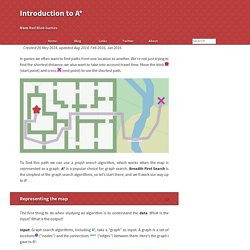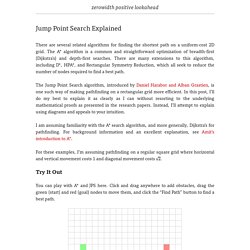

Screeps. GPPC. Rectangle expansion A∗ pathfinding for grid maps. Abstract Search speed, quality of resulting paths and the cost of pre-processing are the principle evaluation metrics of a pathfinding algorithm.

In this paper, a new algorithm for grid-based maps, rectangle expansion A∗ (REA∗), is presented that improves the performance of A∗ significantly. REA∗ explores maps in units of unblocked rectangles. All unnecessary points inside the rectangles are pruned and boundaries of the rectangles (instead of individual points within those boundaries) are used as search nodes. This makes the algorithm plot fewer points and have a much shorter open list than A∗.
Keywords Breaking path symmetries; Grid; Heuristic algorithms; Path search; Variant of A∗ 1. Google search-list group. Amit’s A* Pages. Introduction to A* In games we often want to find paths from one location to another.

We’re not just trying to find the shortest distance; we also want to take into account travel time. Move the blob (start point) and cross (end point) to see the shortest path. To find this path we can use a graph search algorithm, which works when the map is represented as a graph. A* is a popular choice for graph search. Breadth First Search is the simplest of the graph search algorithms, so let’s start there, and we’ll work our way up to A*.
The first thing to do when studying an algorithm is to understand the data. Input: Graph search algorithms, including A*, take a “graph” as input. Sprites by StarRavensee footer for link A* doesn’t see anything else. Output: The path found by A* is . Tradeoffs: For any given game map, there are many different ways of making a pathfinding graph to give to A*. The pathfinding graph doesn’t have to be the same as what your game map uses. There are lots of algorithms that run on graphs. JPS: Fast A* Pathfinding for Uniform Cost Grids. JPS+: discussion. Potential Search Algorithm. JPS Explained. <p><strong>Please note:</strong> this post contains SVG diagrams rendered with javascript.

Please view it in a browser to see all the content. </p> There are several related algorithms for finding the shortest path on a uniform-cost 2D grid. The A* algorithm is a common and straightforward optimization of breadth-first (Dijkstra’s) and depth-first searches. There are many extensions to this algorithm, including D*, HPA*, and Rectangular Symmetry Reduction, which all seek to reduce the number of nodes required to find a best path. The Jump Point Search algorithm, introduced by Daniel Harabor and Alban Grastien, is one such way of making pathfinding on a rectangular grid more efficient. I am assuming familiarity with the A* search algorithm, and more generally, Dijkstra’s for pathfinding. For these examples, I’m assuming pathfinding on a regular square grid where horizontal and vertical movement costs 1 and diagonal movement costs √2̅. Try It Out You can play with A* and JPS here. Notes. PF for grid-based games paper. Nathan Sturtevant, University of Denver.
2017Sufficient Conditions for Node Expansion in Bidirectional Heuristic Search, Jurgen Eckerle, Jingwei Chen, Nathan Sturtevant, Sandra Zilles and Robert Holte, International Conference on Automated Planning and Scheduling (ICAPS) [.bib] Value Compression of Pattern Databases, Nathan R.

Sturtevant, Ariel Felner and Malte Helmert, AAAI Conference on Artificial Intelligence [.bib] Using Hierarchical Constraints to Avoid Conflicts in Multi-Agent Pathfinding, Thayne T. Walker, David Chan and Nathan R. Sturtevant, International Conference on Automated Planning and Scheduling (ICAPS) [.bib] 2016Scrubbing During Learning in Real-Time Heuristic Search, Nathan R. Sturtevant and Vadim Bulitko, Journal of Artificial Intelligence Research (JAIR) [.bib] Bidirectional Search That Is Guaranteed to Meet in the Middle, Robert C.
Holte, Ariel Felner, Guni Sharon and Nathan R. Short Papers, Workshops, Others The Information Discovery Graph: towards a scalable multimedia resource directory, N.R. Trees pathfinding.